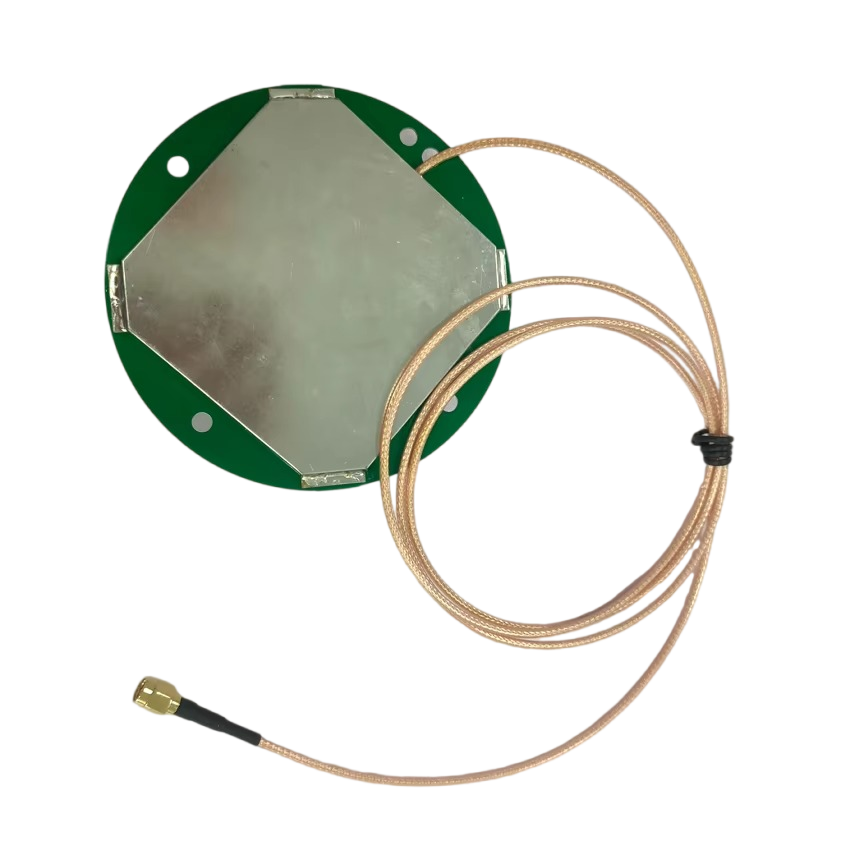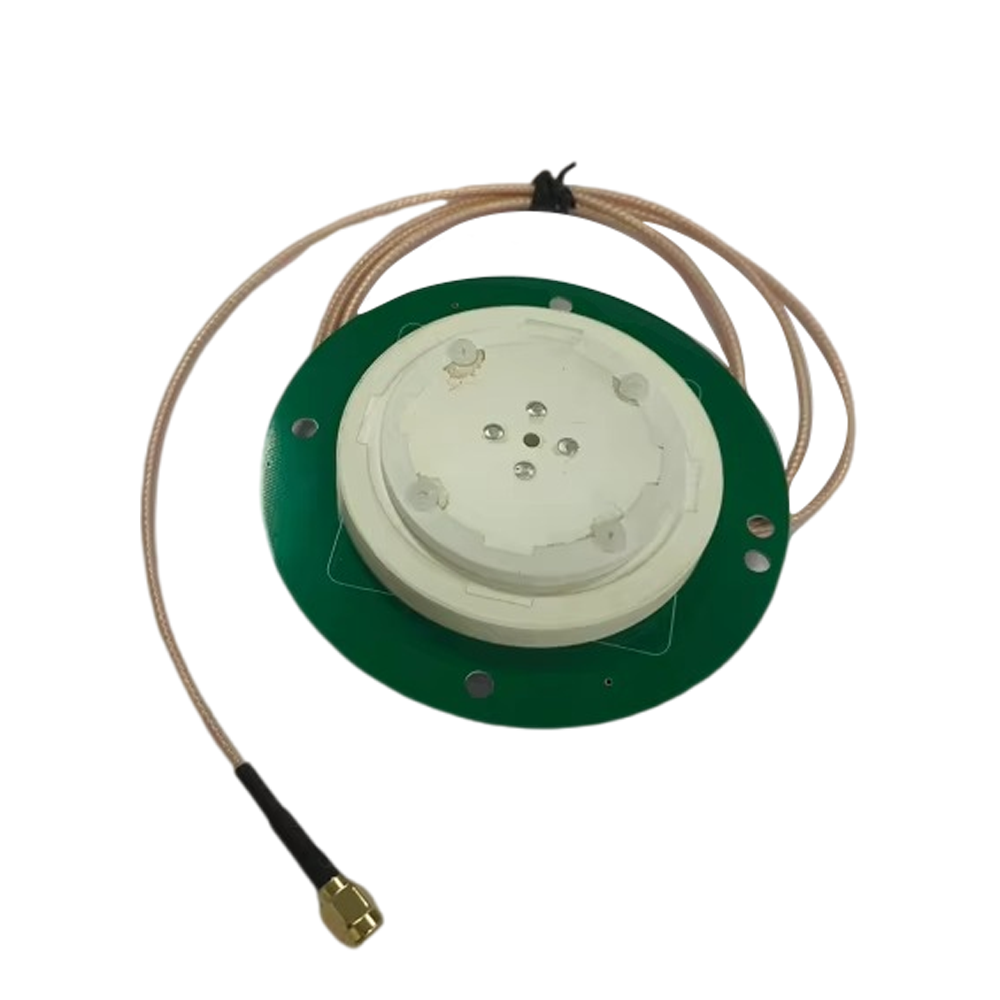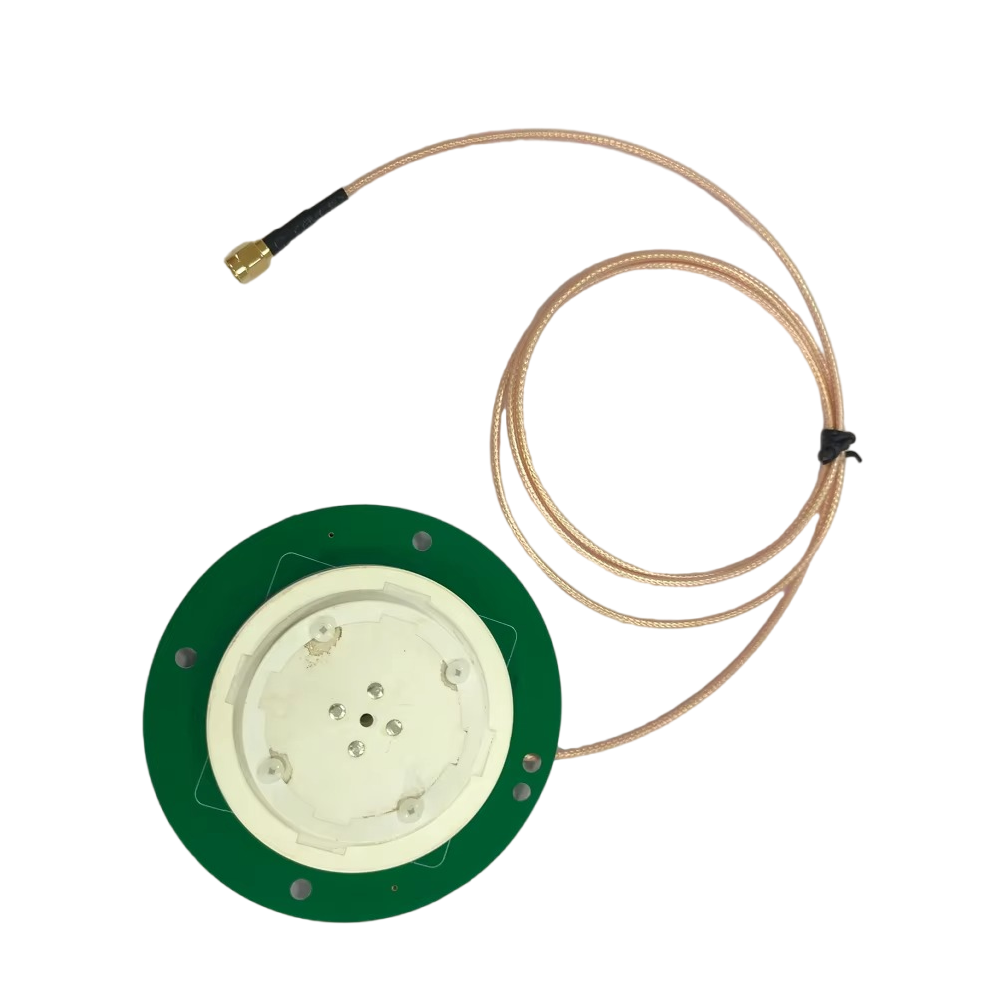Understanding the Role of Combination Antennas in Modern Systems
Combination antennas, as the name suggests, integrate multiple functionalities into a single device, eliminating the need for separate antennas for different tasks. In the case of the GNSS RTK Combination Antenna, this means combining the high-precision positioning capabilities of GNSS RTK with multi-band wireless communication across the 174~240 MHz and 470~862 MHz ranges. These frequency bands are widely used for various applications: 174~240 MHz is commonly employed for VHF (Very High Frequency) communication, including public safety radios, weather monitoring, and broadcast services, while 470~862 MHz covers UHF (Ultra High Frequency) bands used for TV broadcasting, industrial IoT (Internet of Things), smart meters, and wireless sensor networks.
By integrating RTK positioning with communication across these bands, the antenna enables systems to not only determine their precise location in real time but also transmit and receive data wirelessly— a critical requirement for applications such as smart agriculture, industrial monitoring, and public safety. This integration reduces installation complexity, saves space, and minimizes signal interference that can occur when multiple antennas are used in close proximity.
Key Technical Specifications: Engineering for Versatility
The GNSS RTK Combination Antenna is defined by a set of technical specifications that reflect its dual focus on high-precision positioning and reliable communication:
Frequency Range: 174~240 MHz, 470~862 MHz: These two bands cover a broad spectrum of VHF and UHF applications. The 174~240 MHz range supports VHF communication, including emergency services, aviation, and marine radios, while the 470~862 MHz range encompasses UHF TV channels, IoT devices, and industrial wireless systems. This coverage ensures compatibility with a wide range of communication protocols and standards.
VSWR (Voltage Standing Wave Ratio): 1.5 MAX: A maximum VSWR of 1.5 indicates efficient power transfer between the antenna and connected devices. This low VSWR ensures minimal signal reflection, maximizing the amount of power transmitted and received, which is crucial for maintaining signal integrity in both RTK positioning and wireless communication.
Color: Black: The antenna features a black finish, which not only provides a sleek, professional appearance but also helps in heat dissipation and UV resistance. This makes it suitable for outdoor installations where exposure to sunlight and weather elements is common.
Impedance: 75 Ohms: With an impedance of 75 ohms, the antenna is optimized for compatibility with coaxial cables and devices commonly used in broadcast, communication, and TV systems. This is a standard impedance for many video and RF applications, ensuring seamless integration without the need for additional matching components.
Radiation Pattern: Omnidirectional: The antenna’s omnidirectional radiation pattern allows it to transmit and receive signals in all directions, making it ideal for applications where the antenna or the target devices are in motion. This is particularly valuable for mobile systems such as vehicles, drones, or portable monitoring equipment, where maintaining communication and positioning accuracy regardless of orientation is essential.
Gain: 20 dBi with Amplifier: The antenna delivers a high gain of 20 dBi when paired with its integrated amplifier. This gain is critical for extending the range of wireless communication and enhancing the reception of weak signals, both in RTK positioning and data transmission. The amplifier is designed to minimize noise, ensuring that the increased gain does not compromise signal quality.
Connector Type: F-head with TV Adapter: The F-head connector is a standard in TV and satellite systems, known for its secure connection and low signal loss. The inclusion of a TV adapter further enhances compatibility, allowing the antenna to be connected to a wide range of devices, including TVs, radios, RTK receivers, and IoT gateways.
Cable Type: 3M: The antenna is equipped with a 3-meter coaxial cable, providing sufficient length for flexible installation while minimizing signal loss. The cable is designed to be durable and weather-resistant, ensuring reliable performance in outdoor environments.
Antenna Size: 2101200.8 mm: The compact dimensions (210 mm in length, 120 mm in width, and 0.8 mm in thickness) make the antenna suitable for installations where space is limited. Its thin profile allows for discreet mounting on vehicles, walls, or equipment without obstructing other components.
These specifications collectively position the GNSS RTK Combination Antenna as a versatile, high-performance device capable of meeting the demands of both precision positioning and multi-band communication.
Design Features: Integrating Positioning and Communication
The GNSS RTK Combination Antenna’s design incorporates several features that enable its dual functionality and ensure optimal performance:
Multi-Band Radiating Elements: The antenna includes separate radiating elements optimized for the 174~240 MHz and 470~862 MHz bands, as well as elements dedicated to GNSS RTK positioning. These elements are carefully arranged to minimize interference between bands, ensuring that each frequency range operates efficiently without compromising the others. The GNSS elements are typically designed with RHCP (Right-Hand Circular Polarization) to match satellite signals, while the VHF/UHF elements use linear polarization suitable for terrestrial communication.
Integrated Amplifier: The antenna features a built-in amplifier that boosts the gain to 20 dBi, enhancing both signal reception and transmission. The amplifier is placed close to the radiating elements to minimize signal loss before amplification, ensuring that even weak signals are strengthened effectively. It includes filtering components to suppress noise and unwanted signals outside the target frequency ranges, maintaining a high signal-to-noise ratio (SNR).
Impedance Matching Network: To achieve the 75-ohm impedance and low VSWR, the antenna incorporates an impedance matching network. This network ensures that the antenna’s input impedance matches that of the coaxial cable and connected devices, maximizing power transfer and minimizing reflection. This is particularly important for maintaining signal integrity in high-gain systems, where even small mismatches can lead to significant performance degradation.
Durable Housing: The antenna’s housing is designed to protect internal components from environmental factors such as moisture, dust, and physical impact. The black finish is typically made from UV-resistant materials, preventing fading and degradation due to prolonged exposure to sunlight. The thin, lightweight construction (2101200.8 mm) ensures that the antenna can be mounted in various locations without adding excessive weight or bulk.
F-head Connector with TV Adapter: The F-head connector is integrated into the housing, providing a secure interface for the 3-meter coaxial cable. The TV adapter allows the antenna to be connected to devices with different connector types, enhancing versatility. The connector is sealed to prevent moisture ingress, ensuring reliable performance in outdoor environments.
Omnidirectional Radiation Optimization: The radiating elements are designed to achieve an omnidirectional pattern across both frequency bands. This is achieved through careful shaping and positioning of the elements, ensuring that signal strength is consistent in all directions. For the GNSS RTK component, this omnidirectional pattern ensures that satellites can be tracked from any angle, maintaining positioning accuracy.
Cable Design: The 3-meter coaxial cable is chosen for its low loss characteristics, ensuring that the amplified signals are transmitted to the connected device with minimal degradation. The cable is shielded to prevent interference from external RF sources, maintaining signal integrity in noisy environments.
These design features work together to ensure that the GNSS RTK Combination Antenna delivers reliable performance in both positioning and communication, making it a versatile solution for diverse applications.
Performance Capabilities: Balancing Precision and Connectivity
The performance of the GNSS RTK Combination Antenna is measured by its ability to provide high-precision positioning via RTK while maintaining reliable communication across the 174~240 MHz and 470~862 MHz bands. Key performance metrics include:
RTK Positioning Accuracy: The antenna’s GNSS component is designed to support RTK technology, delivering centimeter-level positioning accuracy. This is achieved through precise signal reception from multiple satellite constellations (GPS, GLONASS, BDS, GALILEO) and real-time correction data. The omnidirectional pattern ensures that satellites are tracked consistently, even in dynamic environments.
Communication Range: With a gain of 20 dBi, the antenna extends the communication range significantly compared to standard antennas. This allows for reliable data transmission over longer distances, making it suitable for applications such as remote monitoring, where sensors or devices are spread out over large areas.
Signal Integrity: The low VSWR (≤1.5) and high SNR ensure that both positioning and communication signals remain stable and free from distortion. This is critical for applications such as industrial automation, where even small errors in data transmission or positioning can lead to operational failures.
Interference Resistance: The antenna’s filtering components and multi-band design minimize interference between the GNSS RTK and communication bands, as well as from external RF sources. This ensures that positioning accuracy is not compromised by communication signals, and vice versa.
Environmental Robustness: The durable housing and weather-resistant cable allow the antenna to operate reliably in harsh conditions, including rain, snow, extreme temperatures, and high humidity. This makes it suitable for outdoor applications such as agriculture, construction, and public safety.
Compatibility: The 75-ohm impedance, F-head connector, and TV adapter ensure compatibility with a wide range of devices, including RTK receivers, TVs, radios, IoT gateways, and industrial controllers. This versatility reduces the need for additional adapters or modifications, simplifying installation.
These performance capabilities make the GNSS RTK Combination Antenna a reliable choice for applications that require both high-precision positioning and multi-band communication.
Applications: Bridging Positioning and Communication
The GNSS RTK Combination Antenna finds application in a wide range of industries where the integration of positioning and communication is critical. Key applications include:
Smart Agriculture: In precision agriculture, the antenna enables tractors, harvesters, and drones to maintain centimeter-level positioning via RTK while communicating with a central system over the 470~862 MHz band. This allows for precise application of fertilizers, pesticides, and irrigation, as well as real-time monitoring of crop health and equipment status. The VHF band (174~240 MHz) can be used for communication with nearby farm vehicles or emergency services.
Industrial IoT (IIoT): Industrial facilities use the antenna to track the location of assets (such as tools, containers, or vehicles) with RTK accuracy while transmitting sensor data over the 470~862 MHz band. This enables real-time inventory management, predictive maintenance, and process optimization. The omnidirectional pattern ensures that communication is maintained even as assets move throughout the facility.
Public Safety: Emergency services, including police, fire, and ambulance, rely on the antenna for both precise positioning and reliable communication. The RTK capability ensures that emergency responders can locate incidents with centimeter accuracy, while the VHF band (174~240 MHz) provides secure, long-range communication with dispatch centers and other units. The UHF band can be used for connecting to IoT devices such as surveillance cameras or environmental sensors at the incident site.
Broadcast and Media: Broadcast vehicles use the antenna to maintain precise positioning (for coverage mapping) while receiving or transmitting TV signals over the 470~862 MHz band. The F-head connector and TV adapter simplify integration with broadcast equipment, ensuring high-quality signal transmission. The omnidirectional pattern allows for flexible vehicle positioning without signal loss.
Transportation and Logistics: In logistics, the antenna is used in trucks, ships, and delivery vehicles to track their location with RTK accuracy and communicate with logistics management systems over the UHF band. This enables real-time route optimization, delivery tracking, and fleet management. The VHF band can be used for communication with ports, warehouses, or other vehicles.
Environmental Monitoring: Weather stations, wildlife tracking systems, and pollution monitors use the antenna to transmit data over the 470~862 MHz band while recording the precise location of measurements via RTK. This ensures that environmental data is accurately geotagged, enabling detailed analysis and mapping. The antenna’s durability makes it suitable for deployment in remote or harsh environments.
Smart Cities: In smart city infrastructure, the antenna supports applications such as traffic management, where RTK positioning tracks vehicles and traffic lights, and the UHF band enables communication between traffic sensors and control centers. The VHF band can be used for public address systems or emergency alerts, ensuring that information is disseminated quickly and accurately.
These applications highlight the antenna’s ability to bridge the gap between positioning and communication, providing a unified solution for modern, connected systems.
Installation and Maintenance Best Practices
-
Proper installation and maintenance are essential to ensure the GNSS RTK Combination Antenna performs optimally:
Mounting Location: The antenna should be mounted in a location with an unobstructed view of the sky to maximize GNSS satellite visibility for RTK positioning. For communication, it should be positioned to minimize obstacles between the antenna and target devices, ensuring optimal signal strength. Suitable locations include vehicle roofs, building tops, or elevated poles.
Orientation: While the antenna’s omnidirectional pattern reduces the need for precise alignment, it should be mounted horizontally to ensure consistent performance across all directions. Tilting the antenna can affect both the radiation pattern and polarization, potentially reducing signal strength.
Cable Routing: The 3-meter coaxial cable should be routed to minimize signal loss and interference. Avoid sharp bends, kinks, or proximity to sources of electromagnetic interference (EMI) such as power lines, motors, or other RF devices. Secure the cable with clips or ties to prevent movement and damage.
Connector Handling: Ensure that the F-head connector and TV adapter are properly tightened to prevent signal loss or moisture ingress. Use weatherproof tape or sealants to protect connections in outdoor installations, especially in rainy or humid environments.
Grounding: Proper grounding of the antenna and mounting structure is essential to protect against lightning strikes and reduce EMI. Follow local electrical codes and use appropriate grounding materials to ensure safety and performance.
Amplifier Power Supply: The integrated amplifier requires a stable power supply to operate correctly. Ensure that the power source provides the correct voltage (typically 5V or 12V DC) and current to avoid damage or performance degradation.
Regular Inspection: Periodically inspect the antenna for signs of damage, such as cracks in the housing, loose connections, or cable wear. Clean the antenna surface to remove dirt, debris, or snow that could block signals. Check the VSWR with a meter to ensure it remains within the specified range (≤1.5).
Calibration: For RTK positioning, calibrate the antenna’s position relative to the device or vehicle’s reference point to ensure accurate geotagging. This calibration should be repeated if the antenna is moved or reinstalled.
By following these best practices, users can ensure that the GNSS RTK Combination Antenna delivers reliable performance in both positioning and communication, maximizing its utility in diverse applications.
Conclusion
-
The GNSS RTK Combination Antenna represents a significant advancement in integrated wireless technology, merging high-precision RTK positioning with multi-band communication across the 174~240 MHz and 470~862 MHz ranges. Its technical specifications—including a high gain of 20 dBi, low VSWR of 1.5, and omnidirectional radiation—make it suitable for a wide range of applications, from smart agriculture and industrial IoT to public safety and smart cities.
The antenna’s design, which integrates multi-band radiating elements, an integrated amplifier, and a durable housing, ensures reliable performance in harsh environments while maintaining compatibility with a variety of devices via its F-head connector and TV adapter. By combining positioning and communication capabilities into a single, compact device, it simplifies installation, reduces space requirements, and minimizes interference, making it an ideal solution for modern, connected systems.
As industries continue to demand more integrated and efficient solutions, the GNSS RTK Combination Antenna will play an increasingly important role in enabling the next generation of precision positioning and wireless communication technologies. Its ability to balance accuracy, range, and versatility ensures that it will remain a cornerstone of innovation in diverse fields for years to come.




































































 Language
Language
 En
En Cn
Cn Korean
Korean

 Home >
Home > 







 18665803017 (Macro)
18665803017 (Macro)













